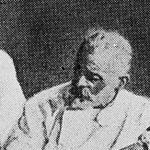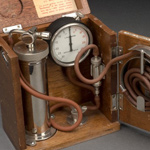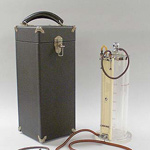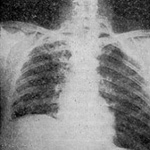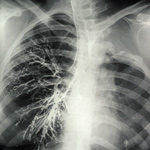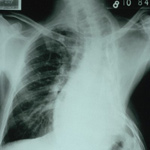Collapse Therapies
Between the 1930s and 1950s, approximately one third of patients with pulmonary TB underwent collapse therapy. Collapse therapies include: pneumothorax, phrenic paralysis, and thoracoplasties. It was thought that collapsing part of the lung would give the lung a rest and a chance to repair itself, and also that collapse would cut off the oxygen supply to TB bacteria in the lung and thereby kill them
Pneumothorax
Carlo Forlanini first raised the idea of artificially collapsing the lung by pneumothorax treatment, to allow the lung to rest and heal, in 1882 and performed the first pneumothorax in 1892.
Air or nitrogen is injected into the intrapleural space, increasing the pressure until the lung collapses. This process reverses naturally, and patients undergoing pneumothorax treatment had to return for gas “top-ups” every few weeks.
In Canada, the first pneumothorax treatment was given in 1898, but the treatment did not become common until the 1930s.
After Dr. Norman Bethune underwent pneumothorax treatment, at his own request, in the late 1920s and saw improvement because of it, he decided to dedicate himself to the improvement of TB treatment. He developed and modified many instruments used in thoracic surgeries, including the pneumothorax machine.
Between 1931 and 1939, 1,600 pneumothorax treatments and 60,000 refills were done at the Queen Alexandra Sanatorium in London, Ontario. Despite such numbers, however, some scholars have speculated that only about 10% of sanatorium patients ever received pneumothorax treatment.
Phrenic Paralysis
Phrenic paralysis is a reversible procedure that inhibits the function of the lung, allowing it to rest. One of the phrenic nerves, which run from the neck to the diaphragm on both the left and right sides of the body, is crushed. This stops the transmission of nervous signals that tell the diaphragm to contract automatically. Without these signals, the diaphragm ceases to contract on the side on which the nerve was crushed, which in turn stops the lung on that side from inflating and deflating. This treatment was common during the 1930s.
Thoracoplasty
The first thoracoplasty surgery was performed in Canada in 1912.
Such surgeries involve the removal of several ribs at a time to cause the deflation of part of the lung. Often several surgeries were needed, as the average patient required the removal of eight ribs before lung collapse was deemed sufficient. One sanatorium patient, Clara Raina Flannigan, had seven ribs removed from her left side and four ribs removed from her right in 1943/44 and 1947, respectively. Although such measures may seem drastic to us today, Clara wanted thoracoplasty surgery as she believed that this was her only chance of fighting tuberculosis.
Thoracoplasties were considered more radical than pneumothorax treatments or phrenic paralysis because there were irreversible. They were generally considered only after long periods of bed rest and other treatments had failed to cause an improvement in the TB patient.
Explore the picture gallery to learn more about this treatment.
